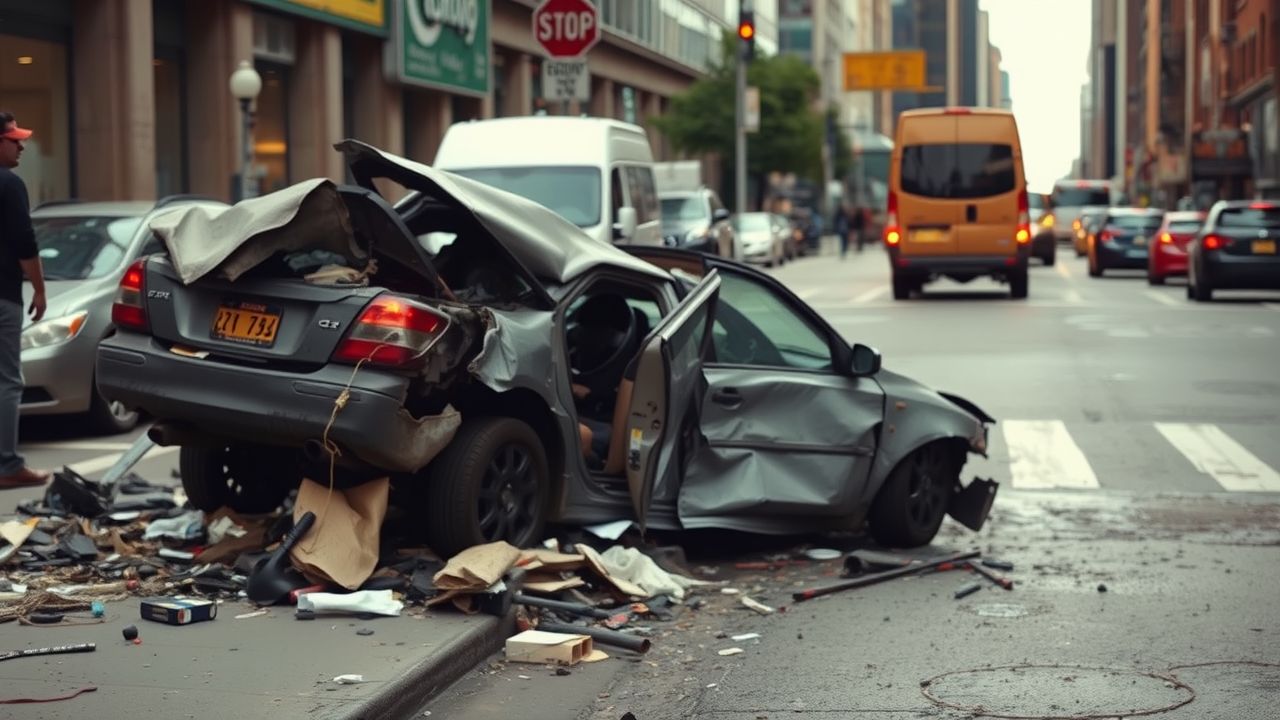Maximum Compensation In NY: What’s Possible After An Accident?

Accidents in New York can lead to significant financial burdens. Understanding the maximum compensation available is crucial for victims seeking fair recovery. New York’s no-fault system provides initial coverage, but serious injuries may allow for further claims.
Medical expenses, lost wages, pain and suffering, and property damage are key areas for potential compensation. The state’s Personal Injury Protection (PIP) covers up to $50,000 for medical costs and 80% of lost wages, capped at $2,000 monthly for three years.
Pain and suffering settlements can range from $125,000 to $1.5 million, without statutory limits. Property damage claims have a minimum coverage of $10,000 per incident. Factors like injury severity, long-term impact, and insurance coverage affect the final compensation amount.
New York’s comparative negligence rule allows victims to seek damages even if partially at fault, though the award may be reduced. Legal representation plays a vital role in maximizing compensation and handling complex claims.
Time limits apply, with most personal injury cases having a three-year statute of limitations. Knowing your rights helps secure fair compensation. Continue reading to learn more about maximizing your claim.
Key Takeaways
- New York allows various types of compensation after an accident, including medical expenses, lost wages, pain and suffering, property damage, and punitive damages.
- Personal Injury Protection (PIP) covers up to $50,000 for medical costs and 80% of lost wages, capped at $2,000 per month for up to three years.
- Pain and suffering damages in New York can range from $125,000 to $1.5 million, with no set caps.
- Victims must file personal injury lawsuits within three years of the incident, or two years for wrongful death cases.
- Legal representation is crucial for maximizing compensation, as attorneys can negotiate with insurance companies and access expert resources to strengthen claims.
Medical Expenses
Medical expenses after an accident in New York can be high. Personal Injury Protection (PIP) covers up to $50,000 for healthcare costs. This includes emergency services, surgeries, and rehab.
PIP also pays for future treatments linked to the accident. Drivers’ insurance covers their passengers’ medical bills. For pedestrians or cyclists hit by a car, the at-fault driver’s insurance pays these costs.
PIP has limits. If medical bills go over $50,000, victims must pay the rest. They can file a lawsuit to get more money. PIP doesn’t cover pain, suffering, or emotional distress from the accident.
Victims should keep all medical records and bills to prove their expenses. This helps them get fair payment for their injuries.
Lost Wages and Earning Capacity
Lost wages cover the money you miss out on after an injury. This includes your regular pay, overtime, bonuses, and even self-employment income. In New York, Personal Injury Protection (PIP) insurance covers 80% of lost wages.
However, it’s capped at $2,000 per month for up to three years. To claim lost wages, you need proof. This means showing pay stubs, getting your employer to verify your work status, and having medical records that explain why you can’t work.
Earning capacity looks at how much money you might lose in the future due to your injury. This is important if you can’t return to your old job or if you have to work fewer hours. Courts look at factors like your age, skills, and education when figuring out future losses.
They also consider how your injury will affect your ability to work long-term. To prove lost earning capacity, you may need expert witnesses. These could be doctors who explain your limitations or economists who calculate your potential losses.
Timely medical treatment and thorough documentation are crucial for maximizing compensation.
Pain and Suffering
Pain and suffering damages in New York can range from $125,000 to $1.5 million. These awards cover both physical pain and emotional distress from an accident. To qualify, victims must meet the state’s serious injury threshold.
This includes injuries like dismemberment, major disfigurement, or impairments that affect daily life for at least 90 days. Unlike some states, New York has no caps on pain and suffering damages.
Courts consider factors such as injury severity and long-term impact when deciding award amounts.
Property Damage
Property damage claims in New York require careful handling. State law mandates a minimum of $10,000 for property damage liability insurance per occurrence. Drivers have three years to file a lawsuit for property damage after an accident.
The no-fault system allows claims with one’s own insurance company. Comparative fault rules affect compensation, so understanding these factors is crucial.
Insurance coverage plays a key role in property damage claims. Collision coverage helps pay for repairs to your vehicle. Liability coverage protects you if you’re at fault for damaging someone else’s property.
Uninsured and underinsured motorist coverage offers extra protection if the other driver lacks enough insurance. Knowing your policy limits and options can help maximize your compensation for property damage after an accident.
Loss of Consortium
Beyond property damage, accidents can harm personal relationships. Loss of consortium claims address this issue. These claims allow spouses to seek damages for injuries that affect their marriage.
Courts may award between $15,000 and $3,000,000 for loss of consortium. The amount depends on factors like marital contributions and intimacy. Spouses must file within three years, with some exceptions.
Only married partners can usually make these claims. Loss of consortium covers more than just physical intimacy. It includes emotional support, companionship, and other marital benefits.
Judges look at how injuries change the couple’s daily life and future plans. This type of claim helps recognize the full impact of accidents on families.
Punitive Damages
Punitive damages serve as a legal tool to punish wrongdoers and deter future misconduct. New York courts may award these damages in cases of extreme wrongdoing, such as intentional harm or gross negligence.
Unlike other forms of compensation, punitive damages aim to penalize the at-fault party rather than make the victim whole. New York law sets no caps on punitive damage amounts, allowing juries to decide based on the case’s specifics.
Courts consider several factors when deciding on punitive damages. These include the nature of the wrongful act, its impact on the victim, and the defendant’s financial status. The law requires clear proof of willful or reckless conduct, fraud, malice, or gross negligence.
Victims must file claims within set time limits: three years for personal injury and two years for wrongful death cases. Legal experts can help victims navigate these complex rules to seek fair compensation.
Additional Factors Affecting Compensation
Several factors can impact your compensation after an accident in New York. Your age, health before the accident, and job status play key roles in determining your payout.
Severity of Injuries
Injury severity plays a key role in determining compensation after an accident in New York. More serious injuries often lead to higher payouts. Spinal cord damage, traumatic brain injuries, severe burns, amputations, and organ damage are examples of catastrophic injuries that may result in larger settlements.
These injuries can have long-lasting effects on a person’s life, impacting their ability to work and enjoy daily activities.
Legal experts can help prove the full extent of injuries and their impact on a victim’s life. They gather medical records, expert opinions, and other evidence to build a strong case for maximum compensation.
In New York’s comparative negligence system, a lawyer can also work to minimize any fault assigned to the injured party, which could reduce their payout. Proper legal representation is vital for securing fair compensation, especially in cases involving severe trauma.
Long-Term Impact
Severe injuries often lead to long-term impacts that stretch far beyond the initial accident. These effects can shape a person’s life for years or even decades. Long-term economic damages include future medical costs and loss of earning capacity.
For instance, a spinal cord injury might require ongoing care and limit job options. Non-economic damages also play a big role in long-term quality of life. Pain, suffering, and emotional distress can persist long after physical wounds have healed.
Specific criteria must be met to pursue compensation for long-term impacts. The severity of injuries greatly influences settlement amounts, which in turn affects long-term finances.
A skilled lawyer can help victims prove these lasting effects and fight for fair compensation. This ensures that accident survivors have the resources they need to manage their new reality and maintain their quality of life.
Insurance Coverage
Insurance coverage plays a key role in accident compensation in New York. The state requires drivers to have minimum coverage of $25,000 for bodily injury per person, $50,000 per accident, and $10,000 for property damage.
New York uses a no-fault system, which means your own insurance pays for medical costs and lost wages up to a certain limit. For serious injuries, victims can file claims against the at-fault driver’s insurance.
Uninsured and underinsured motorist protection can help if the other driver lacks enough coverage. This add-on to your policy fills gaps when the at-fault driver’s insurance falls short.
It’s smart to review your policy limits and consider extra coverage to protect yourself fully. In case of an accident, knowing your policy details can speed up the claim process and ensure you get fair compensation.
Legal Requirements and Limitations
New York law sets strict rules for accident claims. Victims must file personal injury lawsuits within three years of the incident. For wrongful death cases, the time limit shrinks to two years.
These deadlines are crucial, as missing them can result in losing the right to seek compensation. The state also mandates minimum insurance coverage for all drivers. This includes $50,000 for medical expenses, $25,000 for bodily injury per person, and $10,000 for property damage.
New York follows a comparative negligence system. This means a victim’s compensation may decrease if they share fault in the accident. The state also requires uninsured motorist coverage to protect drivers from those without insurance.
For claims beyond basic no-fault benefits, victims must meet the “serious injury” threshold under New York Insurance Law 5102(d). This law defines specific conditions that qualify as serious injuries, allowing for additional compensation claims.
How to Maximize Your Compensation
Maximizing compensation after an accident in New York requires careful planning and action. Follow these steps to increase your chances of receiving the highest possible compensation:
- Document all injuries and medical treatments thoroughly.
- Keep detailed records of all expenses related to the accident.
- File a claim with your Personal Injury Protection (PIP) insurance promptly.
- Gather evidence from the accident scene, including photos and witness statements.
- Avoid discussing fault or details with insurance adjusters without legal counsel.
- Seek medical care immediately and follow all treatment plans.
- Calculate lost wages and future earning capacity accurately.
- Hire a skilled attorney to negotiate with insurance companies.
- Consider filing a lawsuit if insurance settlements are insufficient.
- Pursue compensation for pain and suffering damages.
- Explore options for property damage reimbursement.
- Investigate potential punitive damages in cases of gross negligence.
- Maintain a daily journal detailing your recovery and limitations.
- Obtain expert testimony to support your claims if needed.
- Stay within New York’s statute of limitations for filing claims.
The Role of Legal Representation
Legal experts play a key role in maximizing compensation after an accident. Skilled attorneys ensure clients receive justice through effective use of personal injury law. They handle complex legal tasks, allowing injured parties to focus on recovery.
Lawyers also negotiate with insurance companies to secure higher settlement offers.
Legal counsel brings valuable resources to personal injury cases. Attorneys have access to a network of professionals who can strengthen claims. This network may include medical experts, accident reconstruction specialists, and financial advisors.
With legal representation, clients often obtain better outcomes in their pursuit of fair compensation.
Car Accident Checklist for NY Drivers
New York drivers must be prepared for potential accidents on the road. This checklist outlines crucial steps to take after a car crash in NY.
- Ensure safety first. Move to a safe area if possible and turn on hazard lights.
- Call 911 to report the accident and request medical help if needed.
- Check for injuries and offer help to others involved in the crash.
- Exchange information with other drivers, including names, contact details, and insurance info.
- Take photos of the accident scene, vehicle damage, and any visible injuries.
- Write down details about the crash, such as time, date, location, and weather conditions.
- Get contact info from any witnesses at the scene.
- Avoid admitting fault or discussing the accident details with anyone except the police.
- File a police report and get a copy for your records.
- Seek medical attention, even if you feel fine, as some injuries may not show up right away.
- Contact your insurance company to report the accident.
- Keep all documents related to the accident, including medical bills and repair estimates.
The next section will discuss the role of legal representation in accident cases.
Conclusion
Securing maximum compensation after an accident in NY requires knowledge and action. Victims can recover medical costs, lost wages, and damages for pain and suffering. Legal experts play a crucial role in handling complex claims and maximizing payouts.
Gathering evidence, following doctor’s orders, and acting quickly strengthen your case. Insurance companies aim to minimize payouts, so professional help is essential. Your rights and well-being matter, so take steps to protect them after an accident.
With this information, you’re better prepared to face the challenges ahead and seek fair compensation.
For a comprehensive guide on what to do immediately following a car accident in New York, be sure to read our Car Accident Checklist for NY Drivers.
FAQs
1. What factors determine the maximum compensation for accidents in New York?
The maximum compensation in New York depends on several factors. These include the severity of injuries, medical expenses, lost wages, and pain and suffering. The at-fault party’s insurance coverage limits also play a crucial role. Courts consider all these elements to determine fair compensation.
2. How long do I have to file a claim for accident compensation in New York?
New York law sets specific time limits for filing accident claims. For personal injury cases, you generally have three years from the date of the accident. However, this deadline can vary based on the type of case. It’s crucial to act promptly to protect your rights and ensure you meet all legal deadlines.
3. Can I still receive compensation if I was partially at fault for the accident?
Yes, you can still receive compensation even if you were partially at fault. New York follows a “pure comparative negligence” rule. This means your compensation will be reduced by your percentage of fault. For example, if you’re found 20% at fault, you’ll receive 80% of the total damages awarded.
4. What types of damages can I claim in a New York accident case?
In New York, you can claim various types of damages after an accident. These include economic damages like medical bills and lost wages. You can also claim non-economic damages such as pain and suffering. In some cases, punitive damages may be awarded to punish extremely reckless behavior. An experienced attorney can help you identify all potential damages in your case.
References
- https://www.raphaelsonlaw.com/legal-insights/who-pays-medical-bills-after-a-car-accident-in-new-york
- https://www.rlgfirm.com/articles/who-pays-medical-bills-after-car-accident
- https://orlowlaw.com/understanding-lost-wages-earning-capacity-a-comprehensive-guide/
- https://www.rosenbaumnylaw.com/resources/loss-of-earnings-diminished-earning-capacity/
- https://www.cohenandcohenlawgroup.com/pain-and-suffering-settlement-examples-new-york-emotional-distress-settlement-amounts-near-you/
- https://carrionesq.com/how-much-money-can-you-sue-for-pain-and-suffering-in-new-york/
- https://www.rlgfirm.com/auto-accidents/compensation
- https://www.martellofirm.com/how-much-can-i-sue-for-after-a-car-accident-in-new-york-state/
- https://jknylaw.com/personal-injury-resources/loss-of-consortium/
- https://www.friedmansimon.com/faqs/when-can-you-get-punitive-damages-in-new-york/
- https://www.kesslerlawyer.com/understanding-compensation-calculations-in-personal-injury-cases-in-new-york (2023-04-26)
- https://www.injuriesandaccidents.com/compensation-in-car-accident-claim/ (2024-04-23)
- https://pilaw.com/blog/average-car-accident-payout-in-new-york (2024-11-18)
- https://jknylaw.com/blog/top-10-factors-that-determine-how-much-to-expect-from-a-car-accident-settlement/
- https://www.kesslerlawyer.com/understanding-compensation-in-new-york-car-accidents
- https://tadchievlaw.com/car-accident-laws-in-new-york/ (2024-02-28)
- https://www.buffalolaw.com/car-accident-lawyer/maximizing-your-financial-recovery/
- https://www.hlaw.com/the-impact-of-legal-representation/
- https://www.injuryclaimnyclaw.com/new-york-city-car-accident-checklist/
- https://www.findlaw.com/state/new-york-law/your-new-york-car-accident-the-basics.html (2024-06-16)




